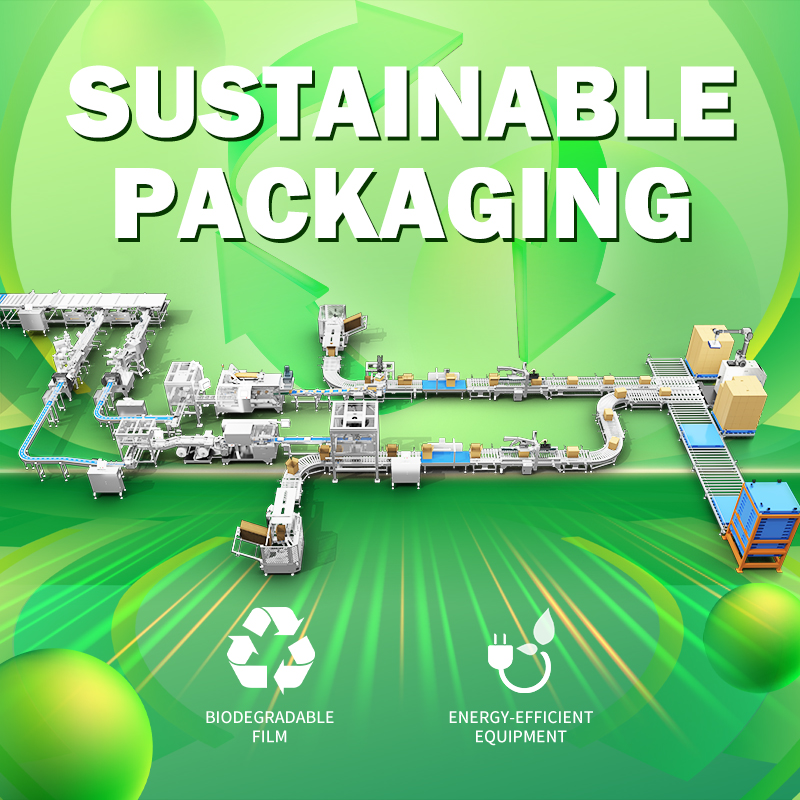Automated Packaging Technology Deep Dive: Efficiency Boost, Smart Innovation & Green Future | Industry Trends Overview
Industry news

If you're seeking packaging automation solutions, please contact us, and we'll be delighted to offer you the most tailored solution.
Introduction: How Automated Packaging Technology is Reshaping Manufacturing
The automated packaging market growth is accelerating rapidly, with the global market projected to expand significantly by 2025. Automation is no longer a trend; it's an industry revolution that is transforming the way goods are packaged, reducing human error, and improving overall efficiency.
Traditional packaging systems often face limitations like capacity bottlenecks, rising labor costs, and increasing environmental regulations. As businesses strive for higher productivity and more sustainable practices, automated packaging solutions offer a clear path forward.
In this article, we’ll explore the key benefits of automated packaging technology, innovations in smart packaging systems, and the green packaging trends shaping the future of the industry.
Core Advantages of Automated Packaging: A Dual Revolution in Efficiency & Cost
3 Key Technological Pillars Driving Production Efficiency
- High-Speed Continuous Operation: Robotic Collaboration
The integration of robotic systems with packaging lines allows for continuous operation, significantly increasing throughput. For example, in the beverage industry, our packaging line can handle 600 bottles per minute in synchronized operations—from labeling to case packing.
- Precision Control: Servo Motors & Vision-Based Positioning
Packaging lines utilizing servo motor precision achieve consistent accuracy, reducing variance to as low as ±0.1mm. Vision-based systems further ensure the correct positioning of each product for error-free packaging.
- 24/7 Uninterrupted Production: Reliability Validation
Predictive maintenance and high-reliability designs enable machines to run non-stop for extended periods, with Mean Time Between Failures (MTBF) often exceeding 10,000 hours.
Cost Optimization: A Key Path to Competitive Advantage
- Labor Cost Reduction: Automation in packaging lines can reduce labor requirements by up to 70% on single lines, compared to traditional manual systems.
- Material Waste Minimization: Smart correction systems can reduce film wastage by more than 15%, improving packaging material usage efficiency.
- Energy Management: Variable frequency drives in machinery help save up to 30% on energy costs, as shown by an annual electricity savings report from a dairy company using automated solutions.
Technological Breakthroughs in Smart Packaging Systems
Industrial 4.0 Core Technologies in Packaging
IoT Integration: Real-Time Monitoring for Equipment Status
The integration of the Industrial IoT (IoT-enabled packaging lines) allows manufacturers to track machine performance and health in real time. For example, predictive maintenance reduces downtime by up to 40%, ensuring that equipment is always in optimal condition and ready for operation.
Machine Vision for Quality Control
AI-powered machine vision systems inspect every package for defects, using deep learning algorithms to detect flaws. The system continuously learns and improves defect detection capabilities, ensuring top-notch quality every time.
Digital Twin Technology
Digital twins simulate packaging lines in a virtual environment, enabling engineers to test and optimize parameters before deployment, resulting in smoother production setup and reduced errors.
Green Packaging: Sustainable Innovations for a Greener Future
Eco-Friendly Material Compatibility Upgrades
With growing demands for sustainable packaging, biodegradable films (PLA/PHA) are becoming increasingly popular. We’ve optimized heat sealing parameters for these materials, ensuring they perform as efficiently as traditional plastics while meeting eco-friendly standards.
Lightweight Packaging Design
Our design team works with brands to reduce film thickness by 30%, maintaining strength while lowering material consumption—helping to reduce environmental impact.
Energy-Saving Equipment Innovations
The incorporation of heat recovery systems in shrink wrap machines can lower energy consumption by 25% by reusing heat from shrink tunnels. Additionally, oil-free vacuum pumps improve both food packaging hygiene and carbon emissions.
Circular Economy Practices
The packaging waste sorting technology using near-infrared spectroscopy enables automated recycling of packaging materials, supporting a closed-loop recycling system. We also align our equipment with EU regulations for Extended Producer Responsibility (EPR), helping businesses stay compliant with environmental laws.
The Future: Packaging Technology Trends (2025–2030)
AI's Deep Integration: Autonomous Decision-Making Systems
AI will enable packaging systems to make autonomous decisions, such as dynamic packaging strategy adjustments in response to changes in supply chains or consumer demand.
Collaborative Robots (Cobots) for Complex Tasks
The next evolution of human-machine collaboration will feature cobots capable of handling delicate and complex packaging tasks, such as fragile item handling, ensuring increased efficiency and flexibility in production.
Carbon Neutrality: The Green Push in Packaging
Innovations like solar-powered packaging lines and carbon footprint tracking systems will help the packaging industry meet sustainability targets and reduce overall carbon emissions.
How to Achieve Packaging Automation: A Step-by-Step Guide
- Initial Assessment: Diagnostic tools for evaluating your current packaging line efficiency.
- Pilot Deployment: Introduce modular devices like smart case packers before full automation.
- Full Integration: Connect your packaging systems to MES systems and data platforms for full-scale automation.
Conclusion: Seizing Technological Benefits to Improve Packaging Efficiency
Investing in automated packaging technology not only boosts production efficiency but also supports sustainability efforts, reduces labor costs, and enhances product quality. Companies that invest in these technologies now will be at the forefront of a smarter, greener packaging future.
For a customized automation upgrade plan or consultation, feel free to contact our experts!
FAQ Section
Q1: How much does the initial investment in automated packaging equipment cost?
A1: The initial investment can vary based on the scale of automation, but ROI is typically realized within 2–3 years due to reduced labor and material waste.
Q2: How do I solve packaging machine clogging issues with biodegradable films?
A2: Adjusting sealing parameters and optimizing machine settings ensures smooth operation, even with materials like PLA/PHA.
Q3: Is AI-based quality control feasible for small businesses?
A3: Yes, AI-powered systems are increasingly affordable and scalable, making them suitable for businesses of all sizes, improving both quality and efficiency.
Q4: What are the new environmental regulations for packaging equipment?
A4: Packaging equipment must align with stricter regulations around sustainability, including EPR (Extended Producer Responsibility) guidelines and recyclable material compatibility.

